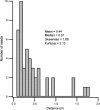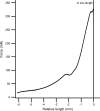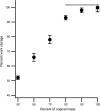The mechanics of explosive seed dispersal in orange jewelweed (Impatiens capensis)
- PMID: 19321647
- PMCID: PMC2682495
- DOI: 10.1093/jxb/erp070
The mechanics of explosive seed dispersal in orange jewelweed (Impatiens capensis)
Abstract
Explosive dehiscence ballistically disperses seeds in a number of plant species. During dehiscence, mechanical energy stored in specialized tissues is transferred to the seeds to increase their kinetic and potential energies. The resulting seed dispersal patterns have been investigated in some ballistic dispersers, but the mechanical performance of a launch mechanism of this type has not been measured. The properties of the energy storage tissue and the energy transfer efficiency of the launch mechanism were quantified in Impatiens capensis. In this species the valves forming the seed pod wall store mechanical energy. Their mass specific energy storage capacity (124 J kg(-1)) was comparable with that of elastin and spring steel. The energy storage capacity of the pod tissues was determined by their level of hydration, suggesting a role for turgor pressure in the energy storage mechanism. During dehiscence the valves coiled inwards, collapsing the pod and ejecting the seeds. Dehiscence took 4.2+/-0.4 ms (mean +/-SEM, n=13). The estimated efficiency with which energy was transferred to the seeds was low (0.51+/-0.26%, mean +/-SEM, n=13). The mean seed launch angle (17.4+/-5.2, mean +/-SEM, n=45) fell within the range predicted by a ballistic model to maximize dispersal distance. Low ballistic dispersal efficiency or effectiveness may be characteristic of species that also utilize secondary seed dispersal mechanisms.
Figures






References
-
- Abramoff MD, Magelhaes PJ, Ram SJ. Image processing with ImageJ. Biophotonics International. 2004;11:36–42.
-
- Afonso Júnior PC, Corrêa PC, Pinto FAC, Queiroz DM. Aerodynamic properties of coffee cherries and beans. Biosystems Engineering. 2007;98:39–46.
-
- Ågren J, Willson MF. Gender variation and sexual differences in reproductive characters and seed production in gynodioecious Geranium maculatum. American Journal of Botany. 1991;78:470–480.
-
- Argyres AZ, Schmitt J. Microgeographic genetic structure of morphological and life history traits in a natural population of Impatiens capensis. Evolution. 1990;45:178–189. - PubMed
-
- Augspurger CK. Seedling survival of tropical tree species: interactions of dispersal distance, light-gaps, and pathogens. Ecology. 1984;65:1705–1712.

